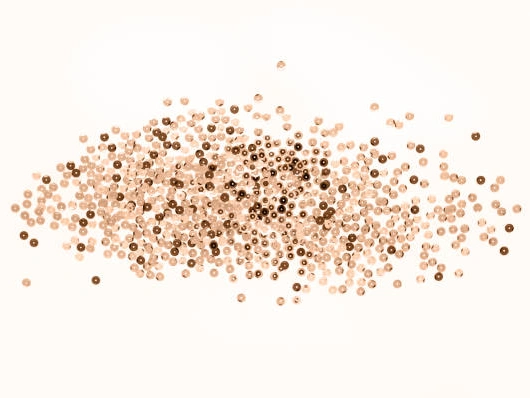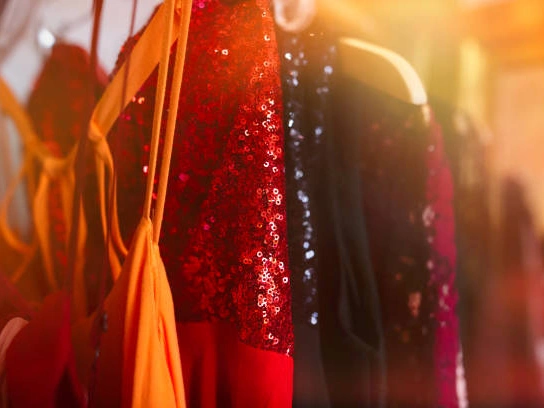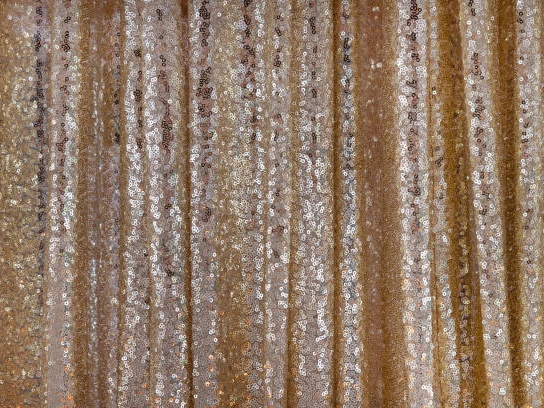Sequin fabric dazzles as a visual centerpiece, but beneath its shimmering surface lies a sophisticated interplay of materials and craftsmanship. As a composite material, it is not a single entity but a union of two core components: the sequins themselves and the base fabric. The sequins, crafted from plastic, metal, or glass, serve as the decorative heart, leveraging their optical properties to capture light, while the base fabric—whether silk, tulle, or cotton—provides structural support. Together, their synergy defines the fabric’s texture, durability, and visual impact.
Types of Sequin Fabrics

Sequin fabrics come in a vast array of styles, each defined by the size, shape, material, and density of sequins, as well as the base fabric they adorn. Below are distinct types that cater to diverse design needs, from subtle elegance to bold theatricality:
Micro-Sequin Fabric
- Characteristics: Features tiny sequins (1–3mm), often round or oval, densely packed on lightweight bases like chiffon or mesh.
- Aesthetic: Creates a soft, pearlescent glow rather than aggressive sparkle, ideal for understated luxury. The minuscule size allows for fluid drape, making it popular in evening gowns or cocktail dresses.
- Use Case: Subtle party wear, bridal veils, or upscale loungewear where texture over shine is desired.
Oversized Sequin Fabric
- Characteristics: Showcases large sequins (10 mm+), often in geometric shapes (squares, triangles) or bold rounds, on structured bases like denim or polyester blends.
- Aesthetic: Delivers high-impact, retro-inspired glamour, reminiscent of 1980s disco or modern streetwear. The spacing between sequins may be intentional, creating a patchwork effect.
- Use Case: Stage costumes, festival outfits, statement jackets, or decorative cushions that demand attention.
Iridescent/Holographic Sequin Fabric
- Characteristics: Sequins with multi-colored, light-shifting coatings (often plastic or polyester) that reflect rainbow hues. Paired with sheer bases like organza for maximum light play.
- Aesthetic: Futuristic and whimsical, perfect for creating dynamic, “moving” visuals under different lighting.
- Use Case: Children’s costumes, rave wear, party backdrops, or fashion-forward accessories like tote bags.
Matte Sequin Fabric
- Characteristics: Sequins with non-reflective surfaces, made from matte-finish plastic or coated metal. Often paired with luxe bases like velvet or linen for contrast.
- Aesthetic: Sophisticated and modern, offering texture without glitter. The muted shine adds depth to minimalist designs.
- Use Case: High-end casual wear (e.g., matte black sequin skirts), bohemian-inspired dresses, or elegant home decor like lampshades.
Mixed-Media Sequin Fabric
- Characteristics: Combines sequins with other embellishments like beads, pearls, or embroidery threads on layered bases (e.g., lace over tulle).
- Aesthetic: Rich, tactile, and artisanal, blending sparkle with intricate detailing.
- Use Case: Couture gowns, wedding dresses, or heritage-inspired designs (e.g., Indian lehenga or African dashiki).
Eco-Friendly Sequin Fabric
- Characteristics: Uses sustainable materials like recycled plastic, plant-based polymers (e.g., cellulose acetate), or upcycled metal/glass. Often paired with organic cotton or hemp bases.
- Aesthetic: Aligns with minimalist or earthy styles, proving sustainability doesn’t sacrifice shine.
- Use Case: Ethical fashion brands, eco-conscious event decor, or slow fashion pieces.
3D/Embossed Sequin Fabric
- Characteristics: Sequins with raised textures or layered designs (e.g., star-shaped sequins with embedded crystals). Crafted on stiff bases like PVC or felt for structure.
- Aesthetic: Dramatic and tactile, adding dimension to flat surfaces.
- Use Case: Theatrical costumes, avant-garde fashion, or statement accessories like clutch bags.
Key Takeaway
The diversity of sequin fabrics lies in their ability to adapt to mood, function, and ethics. Whether you seek understated elegance (micro-sequins), eco-consciousness (recycled materials), or bold nostalgia (oversized disks), each type demonstrates how small changes in material and design can create vastly different effects. As fashion and decor evolve, sequin fabrics continue to innovate, proving that their sparkle is matched only by their versatility.
Which Base Fabrics Can Support Sequins?

The Significance of Base Fabrics
Base fabrics play a pivotal role in sequin fabric construction, as they significantly influence key characteristics such as drape, elasticity, weight, and durability. These attributes, in turn, determine the overall hand feel of the sequin fabric and its suitability for various applications. Whether it’s a flowing evening gown, a form-fitting dance costume, or a structured decorative piece, the base fabric serves as the essential canvas upon which the sequins work their visual magic.
Common Base Fabric Materials
Cotton Blends: Cotton blends can provide better structure for specific designs, combining the natural breathability of cotton with enhanced durability and stability, making them a practical choice for long-lasting sequin fabric items.
Lightweight and Breathable
Mesh/Tulle: With its open, airy structure, mesh or tulle allows sequins to stand out prominently. Widely used in fashion, these fabrics add a touch of elegance and a sense of movement to garments.
Chiffon: Known for its delicate, transparent, and refined appearance, chiffon provides a soft, flowing backdrop that enhances the sparkle of sequins, making it a popular choice for feminine designs.
Georgette: Similar to chiffon, georgette offers a flowing, billowy quality, creating a captivating contrast with the shimmer of sequins.
Luxurious and Smooth
Satin (Polyester, Silk Blends): Satin fabrics, whether in polyester or silk blends, add a rich, lustrous sheen to sequin fabric. This enhances the overall opulence of the material, making it ideal for high-end evening wear.
Silk: Renowned for its premium hand feel and excellent drape, silk provides a sumptuous base that complements the glamour of sequins, often used in luxury fashion items.
Elastic and Comfortable
Spandex/ Lycra Blends: These highly elastic fabrics are perfect for form-fitting garments and dance costumes, ensuring a snug yet comfortable fit while allowing freedom of movement.
Knitted Fabrics (Polyester, Rayon Blends): With their inherent flexibility, knitted blends offer comfort and stretch, making them suitable for a wide range of casual and activewear designs adorned with sequins.
Warp Knits: Commonly used in swimwear and sportswear, warp knits typically feature good elasticity, allowing sequin-decorated pieces to conform to the body’s contours.
Durable and Structured
Polyester Blends: Versatile and hard-wearing, polyester blends are suitable for everyday clothing and various decorative applications. They can withstand regular use and maintain the integrity of the sequin fabric.
Cotton Blends: Cotton blends can provide better structure for specific designs, combining the natural breathability of cotton with enhanced durability and stability, making them a practical choice for long-lasting sequin fabric items.
What is Sequin Fabric Made Of

The creation of sequin fabric typically involves two main components: the sequins themselves and the base fabric.
- Sequins: Traditionally, sequins were made from actual metal coins or polished shells. Today, most sequins are manufactured from various types of plastic, such as PVC or PET, which are cut into thin discs. These discs are then often coated with metallic finishes, holographic films, or iridescent colors to enhance their reflective properties.
- Base Fabric: Sequins are attached to a wide range of base fabrics, influencing the overall drape, stretch, and feel of the finished material. Common base fabrics include:
- Mesh or Tulle: These lightweight, sheer fabrics allow the sequins to stand out and create a delicate, ethereal look.
- Satin or Silk: Provide a luxurious backing that enhances the overall richness of the sequin embellishment.
- Knit or Stretch Fabrics (e.g., Spandex, Tricot): Offer flexibility and comfort, making them ideal for form-fitting garments like dancewear, leggings, and cocktail dresses.
- Cotton or Polyester Blends: Can be used for more structured garments or decorative items.
Once the sequins are manufactured, they are attached to the base fabric through various methods:
Embroidering: Sequins can be incorporated into intricate embroidery designs, adding texture and sparkle to patterns.
Sewing: This is the most common and durable method. Sequins are individually machine-stitched or hand-sewn onto the fabric. They can be stitched flat or at a single point to allow them to dangle and catch more light.
Gluing: For some applications, especially in craft or temporary decor, sequins might be glued onto the fabric.
How Are Sequins Attached to Fabric?

Sequins are fixed to fabric through techniques that balance durability and design, with three main methods:
Sewing (Most Reliable)
Sewing is the go-to for long-lasting wear:
- Machine sewing uses industrial equipment to stitch sequins in rows via specialized needles, ideal for large-scale projects like stage costumes. This method ensures speed and consistency.
- Hand sewing employs meticulous stitches like flat stitches or single-point suspension for intricate designs. Artisans use this for couture, threading through sequin holes to secure them with precision, often leaving slight gaps for added sparkle.
Adhesive Bonding
Quick and flexible, adhesive methods suit temporary uses:
- Textile glues (e.g., heat-activated resins) bond sequins directly to fabric, favored for party decor or fast-fashion items. Lightweight sequins on materials like tulle work best here.
- Drawback: Less durable than sewing, glued sequins may peel after washing or friction, making them suitable for short-term pieces.
Embroidery Integration
Modern approaches blend sequins with stitching:
- Computerized embroidery machines place sequins within programmed patterns, stitching around or through them to create complex motifs. This integrates sequins seamlessly into designs like floral or geometric prints.
- Hand-embroidery hybrids combine sequins with beads or thread for textured, artisanal effects, common in high-end accessories.
From machine-sewn durability to glued efficiency and embroidered artistry, these techniques ensure sequin fabric shines in everything from everyday wear to elaborate costumes, proving that craftsmanship lies in the smallest details.
The Influence of Materials on the Properties of Sequin Fabrics

The materials used in sequin fabric directly impact its key characteristics. Durability hinges on sequin type: plastic is lightweight but prone to wear, metal offers ruggedness, and glass is delicate. Base fabrics like polyester blends resist tearing, while silk demands careful handling. Handfeel and comfort depend on textures—smooth plastic or soft rayon blends enhance wearability, versus stiff cotton or metallic sequins that feel harsh. Care requirements vary by material: machine-washable polyester with sewn sequins suits everyday use, while silk with glued sequins needs gentle hand-washing.
Sustainability-wise, plastic sequins raise recycling challenges, but eco-alternatives like plant-based polymers or recycled glass are gaining traction. Cost reflects material choices: affordable plastic on polyester dominates fast fashion, while premium metal/glass on silk commands luxury prices due to rarity and craftsmanship. Balancing these elements ensures sequin fabric meets functional, aesthetic, and SEO-friendly sustainability goals—ideal for fashion, decor, and beyond.
Conclusion
Sequined fabric is a sophisticated combination of materials, each element playing a vital role in its allure. At its core, it’s the harmonious blend of sequins and base fabric. The sequins determine its sparkle and durability, while the base fabric determines its drape, comfort, and functionality. From the subtle shimmer of sequins on chiffon to the bold allure of oversized metallic discs on satin, these elements work together to transform a simple fabric into a dynamic canvas for creativity.
